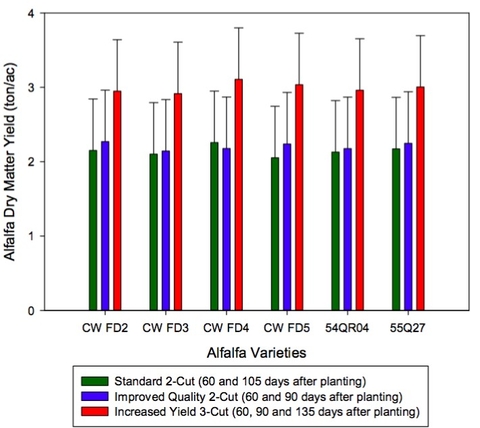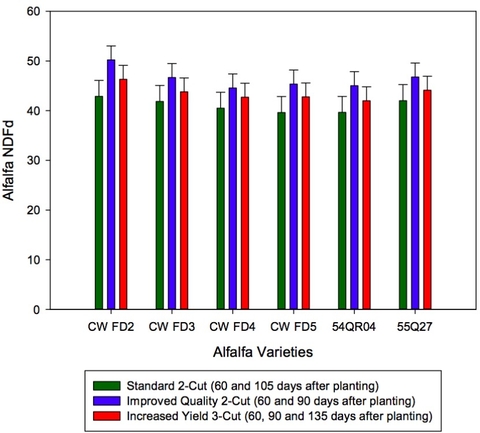For more than 60 years, alfalfa yields, forage quality and persistence have increased thanks to improved genetics, disease and insect control and more intensive nutrient and harvest management.
Despite substantial work in improving alfalfa production, these technologies and research findings focus on the first through third production years. Research on seeding year yield improvements is limited.
However, increasing seeding year yields is a potential area for improvement that could ultimately help producers maximize revenue.
When there are high-yielding varieties and high alfalfa hay prices, there’s incentive to develop management practices that improve seeding year management and optimize the total revenue stream.
Improving seeding year yields is one potential area for optimization. Current recommendations for seeding year management were designed to ensure enhanced persistence throughout the production years.
In 1972, researchers reported greater seeding-year alfalfa yields in a three-harvest system compared to a two-harvest system. They also reported that, under ideal situations, maximum seed year yield expectations were 40 to 60 percent of those from established alfalfa.
In Minnesota, research found that seeding year yield and nutrient concentrations were maximized by early May seedings with initial harvest 60 days later at bud stage with an additional two to three harvests per year.
Other studies explored the potential for seeding year yield improvement by mixing the seed of non-dormant alfalfa that has more seeding year growth with conventionally dormant alfalfa varieties. However, findings demonstrated that including non-dormant seed with dormant alfalfas in the seeding year reduced yields in the year following seeding because the non-dormant alfalfa had died.
Minnesota forage production, including alfalfa hay and haylage, dry hay and corn silage, totaled more than 3.5 million acres in 2017.
Taking a closer look, more than 3.8 million tons of hay were produced in Minnesota in 2017. This level of production generated revenue from direct sales of $365 million dollars.
It’s important to note the total hay forage revenue was based on an average yield of only 2.8 tons per acre. If annual production increased by 10 percent, this relatively small increase of 0.3 tons per acre would equate to more than $36 million in annual revenues.
Research: Seeding year harvest
To expand knowledge on seeding year management, we conducted research that sought to evaluate how seeding year harvest regimes affected on forage yield, quality and persistence of new, moderate to semi-dormant alfalfa varieties.
To do this, we implemented three seeding year cutting management strategies to six alfalfa varieties at three Minnesota locations.
New, moderately dormant to semi-dormant alfalfa varieties are characterized as very winter-hardy to winter-hardy.
The increased fall and spring growth potential of the new semi-dormant, winter-hardy alfalfa varieties provide opportunities for developing new management strategies that could increase yield in the seeding year without hampering persistence and yield in production years.
Varieties and locations
In spring 2014, six alfalfa varieties (four from Alforex Seed and two from Pioneer) with fall dormancies ranging from two to five were direct-seeded at three University of Minnesota Research and Outreach Centers: Rosemount, Becker and St. Paul.
Cutting management strategies
Researchers subjected alfalfa varieties to three seeding year cutting management strategies of increasing harvest intensities:
- Standard two-cut system in which alfalfa was harvested 60 and 105 days after planting.
- Improved quality two-cut in which alfalfa was harvested 60 and 90 days after planting.
- Increased yield three-cut system in which alfalfa was harvested 60, 90 and 135 days after planting. The final harvest occurred in the fall (i.e., early October).
Yield and quality
Researchers assessed forage yield (dry matter) and quality for each harvest interval. The newly seeded alfalfa was kept weed-free by using post-emergent broadleaf and grass herbicides.
Study results
Yield
Averaged across the three locations, yield didn’t differ across the six alfalfa varieties (Figure 1).
Alfalfa yields for both two-cut systems for all six alfalfa varieties ranged from 0.9 to 4.0 tons per acre, whereas yields from the three-cut system ranged from 1.5 to 5 tons per acre. Alfalfa varieties had similar yields for both of the two-cut systems. Not surprisingly, the three-cut system outyielded both the two-cut systems by nearly 1 ton per acre.
A cutting system with a fall-cut greatly improved the total season year yields. However, the fall harvest reduced first-cut yields in the year following seeding by 3 percent (1.28 tons per acre) compared to the two-cut systems (1.38 tons per acre).
Quality
Although forage quality was also similar across alfalfa varieties, cutting treatments influenced neutral detergent fiber digestibility (NDFD), as shown in Figure 2. Crude protein was similar across both alfalfa varieties and cutting treatments, ranging from 22 to 24 percent.
Alfalfa varieties in the improved quality two-cut regimen, with cutting 90 days after planting, had increased NDFD values compared to the standard two-cut and three-cut systems.
The most dormant alfalfa variety in the study, CW FD2, had the highest NDFD. This isn’t surprising, because maturation would’ve been slower, increasing the quality. The CW FD2 variety would’ve most likely been in the vegetative to bud stage, while the other alfalfa varieties would’ve most likely been in the bud to early flower stage.
Brummer, E.C., Moore, K.J. & Bjork, N.C. (2002). Agronomic consequences of dormant - non-dormant alfalfa mixtures. Agronomy Journal, 94, 782-785.
National Alfalfa & Forage Alliance (NAFA). (2013). Winter survival, fall dormancy and pest resistance ratings for alfalfa varieties.
Sheaffer, C.C. (1983). Seeding year harvest management of alfalfa. Agronomy Journal, 1: 115-119.
Tesar, M.B. & Jackobs, J.A. (1972). Establishing the stand. In C.M. Hansen (Ed.), Alfalfa Science and Technology (pp. 415-435). Madison, WI: American Society of Agronomy.
U.S. Department of Agriculture National Agricultural Statistics Service. (2014). State Agriculture Overview: Minnesota.
Reviewed in 2018



